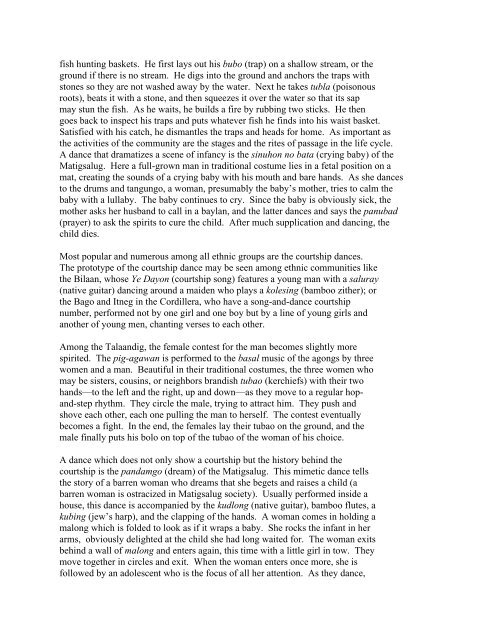THE ETHNIC TRADITION IN PHILIPPINE THEATER In the ...
THE ETHNIC TRADITION IN PHILIPPINE THEATER In the ...
THE ETHNIC TRADITION IN PHILIPPINE THEATER In the ...
Create successful ePaper yourself
Turn your PDF publications into a flip-book with our unique Google optimized e-Paper software.
fish hunting baskets. He first lays out his bubo (trap) on a shallow stream, or <strong>the</strong><br />
ground if <strong>the</strong>re is no stream. He digs into <strong>the</strong> ground and anchors <strong>the</strong> traps with<br />
stones so <strong>the</strong>y are not washed away by <strong>the</strong> water. Next he takes tubla (poisonous<br />
roots), beats it with a stone, and <strong>the</strong>n squeezes it over <strong>the</strong> water so that its sap<br />
may stun <strong>the</strong> fish. As he waits, he builds a fire by rubbing two sticks. He <strong>the</strong>n<br />
goes back to inspect his traps and puts whatever fish he finds into his waist basket.<br />
Satisfied with his catch, he dismantles <strong>the</strong> traps and heads for home. As important as<br />
<strong>the</strong> activities of <strong>the</strong> community are <strong>the</strong> stages and <strong>the</strong> rites of passage in <strong>the</strong> life cycle.<br />
A dance that dramatizes a scene of infancy is <strong>the</strong> sinuhon no bata (crying baby) of <strong>the</strong><br />
Matigsalug. Here a full-grown man in traditional costume lies in a fetal position on a<br />
mat, creating <strong>the</strong> sounds of a crying baby with his mouth and bare hands. As she dances<br />
to <strong>the</strong> drums and tangungo, a woman, presumably <strong>the</strong> baby’s mo<strong>the</strong>r, tries to calm <strong>the</strong><br />
baby with a lullaby. The baby continues to cry. Since <strong>the</strong> baby is obviously sick, <strong>the</strong><br />
mo<strong>the</strong>r asks her husband to call in a baylan, and <strong>the</strong> latter dances and says <strong>the</strong> panubad<br />
(prayer) to ask <strong>the</strong> spirits to cure <strong>the</strong> child. After much supplication and dancing, <strong>the</strong><br />
child dies.<br />
Most popular and numerous among all ethnic groups are <strong>the</strong> courtship dances.<br />
The prototype of <strong>the</strong> courtship dance may be seen among ethnic communities like<br />
<strong>the</strong> Bilaan, whose Ye Dayon (courtship song) features a young man with a saluray<br />
(native guitar) dancing around a maiden who plays a kolesing (bamboo zi<strong>the</strong>r); or<br />
<strong>the</strong> Bago and Itneg in <strong>the</strong> Cordillera, who have a song-and-dance courtship<br />
number, performed not by one girl and one boy but by a line of young girls and<br />
ano<strong>the</strong>r of young men, chanting verses to each o<strong>the</strong>r.<br />
Among <strong>the</strong> Talaandig, <strong>the</strong> female contest for <strong>the</strong> man becomes slightly more<br />
spirited. The pig-agawan is performed to <strong>the</strong> basal music of <strong>the</strong> agongs by three<br />
women and a man. Beautiful in <strong>the</strong>ir traditional costumes, <strong>the</strong> three women who<br />
may be sisters, cousins, or neighbors brandish tubao (kerchiefs) with <strong>the</strong>ir two<br />
hands—to <strong>the</strong> left and <strong>the</strong> right, up and down—as <strong>the</strong>y move to a regular hopand-step<br />
rhythm. They circle <strong>the</strong> male, trying to attract him. They push and<br />
shove each o<strong>the</strong>r, each one pulling <strong>the</strong> man to herself. The contest eventually<br />
becomes a fight. <strong>In</strong> <strong>the</strong> end, <strong>the</strong> females lay <strong>the</strong>ir tubao on <strong>the</strong> ground, and <strong>the</strong><br />
male finally puts his bolo on top of <strong>the</strong> tubao of <strong>the</strong> woman of his choice.<br />
A dance which does not only show a courtship but <strong>the</strong> history behind <strong>the</strong><br />
courtship is <strong>the</strong> pandamgo (dream) of <strong>the</strong> Matigsalug. This mimetic dance tells<br />
<strong>the</strong> story of a barren woman who dreams that she begets and raises a child (a<br />
barren woman is ostracized in Matigsalug society). Usually performed inside a<br />
house, this dance is accompanied by <strong>the</strong> kudlong (native guitar), bamboo flutes, a<br />
kubing (jew’s harp), and <strong>the</strong> clapping of <strong>the</strong> hands. A woman comes in holding a<br />
malong which is folded to look as if it wraps a baby. She rocks <strong>the</strong> infant in her<br />
arms, obviously delighted at <strong>the</strong> child she had long waited for. The woman exits<br />
behind a wall of malong and enters again, this time with a little girl in tow. They<br />
move toge<strong>the</strong>r in circles and exit. When <strong>the</strong> woman enters once more, she is<br />
followed by an adolescent who is <strong>the</strong> focus of all her attention. As <strong>the</strong>y dance,
















